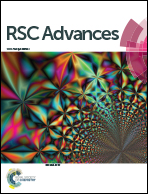Structural and CO2 capture analyses of the Li1+xFeO2 (0 ≤ x ≤ 0.3) system: effect of different physicochemical conditions
Abstract
In this work, we studied α-LiFeO2 compounds and the effect of lithium excess on CO2 capture properties. The α-LiFeO2 phase (cubic phase) was synthesized using the nitrate pyrolysis method at moderate temperature and a short calcination time (up to 670 °C and 3 h). Four compositions were synthesized with the nominal formula Li1+xFeO2 for 0 ≤ x ≤ 0.3, obtaining α-LiFeO2 phases with different lattice parameters. The specific surface area was calculated for all the compounds from the BET model, fitting the N2 adsorption–desorption curves. The CO2 capture was studied under two different sets of physicochemical conditions. Initially, the CO2 capture was analysed at high temperature, where the Li1.3FeO2 composition showed the best properties at T > 600 °C. It was found that the amount of CO2 captured at T > 600 °C depended on the lithium excess in the sample. Isothermal studies were performed in the 400–700 °C range, and the curves were fitted to a double exponential model. Kinetic constants were used in the Eyring formalism to obtain the activation enthalpies (ΔH≠) for the surface and bulk reactions. These values were similar to those reported for other Li-based ceramics. The CO2 capture process in the presence of steam was evaluated at low temperature (from 40 °C to 80 °C, varying the relative humidity from 0 to 80%). In these physicochemical conditions, Li1.3FeO2 could capture up to 24 wt% CO2. This characterization has not previously been performed on these compounds. After CO2 and steam capture, the product obtained contained magnetite, which is an iron oxide with mixed Fe2+ and Fe3+ oxidation states. The origin of the Fe2+ is attributed to the excess lithium added to the crystalline system. Its presence was confirmed by XPS spectroscopy, and it was also possible to identify two different chemical environments for oxygen ions, indicating that the Li+ ions occupy two different crystal sites. We associated the high reactivity of compounds under a steam and CO2 atmosphere with the presence of both Fe2+ and the interstitial Li+ species.


 Please wait while we load your content...
Please wait while we load your content...